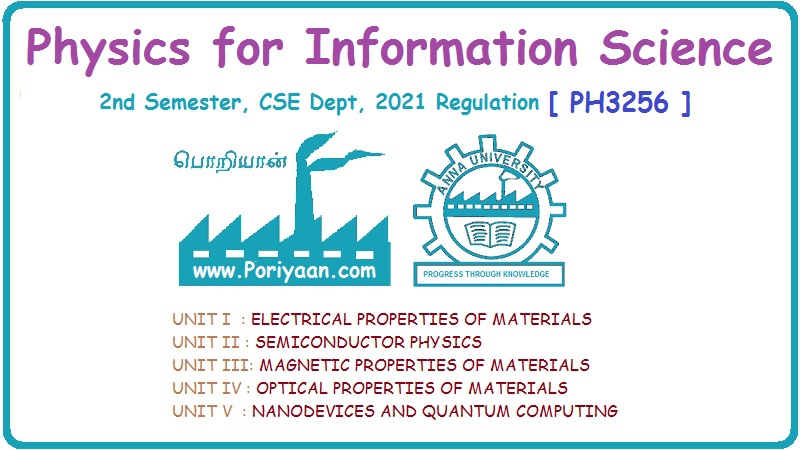Physics for Information Science: Unit I: Electrical Properties of Materials
Expression for Thermal Conductivity
Formula, Unit, Equation
Let us consider a uniform rod AB with the temperatures T1 (Hot) at end 'A' and T2 (cold) at end B. Heat flows from hot end 'A' to the cold end 'B'.
EXPRESSION FOR
THERMAL CONDUCTIVITY
Let us consider a uniform rod AB with the temperatures T1 (Hot) at end 'A' and T2 (cold) at end B. Heat flows from hot end 'A' to the cold end 'B'. Let us consider a cross sectional area 'C' which is at a distance equal to the mean free path (λ) of the electron between the ends A and B of the rod as shown in Fig. 1.5.
The
amount of heat (Q) conducted by the rod from the end A to B of length 2 λ
is given by
(or)….(1)
where
K→ Coefficient of thermal conductivity
A→
Area of cross section of the rod
T1-T2 → Temperature difference between the ends A and B
t
→ Time for conduction
2
λ
→ Length of rod (A to B)
From
equation (1) we can write
Coefficient
of thermal conductivity per unit area per unit time
….(2)
Let us assume that there is equal probability for the electrons to move in all the six directions as shown in Fig. 1.6. Since each electron travels with thermal velocity v, if 'n' is the free electron density, then on an average 1/6 nv electrons will travel in any one direction.
The number of electrons crossing
unit area per unit time at
….(3)
According to kinetic theory of gas, [Since free electrons are assumed to be gas molecules which are freely moving]
The
average kinetic energy of an electron at hot end 'A' of temperature (T1)
The
average kinetic energy of an electron at cold end 'B' of temperature (T2)
where KB→ Boltzmann constant = 1.380 × 10-23 J/K
…..(4)
Similarly,
the heat energy transferred per unit area per unit time from end B to A across
…..(5)
The
net heat energy transferred from end A to B per unit area per unit time across
'C' can be got by subtracting equation (5) from equation (4)
…..(6)
Substituting
equation (6) in equation (2) we have
(or) …..(7)
We
know for metals.
Relaxation
time (τ) = Collision time (τc)
(i.e.,) τ = τ c= λ/v
τ
v =λ ….(8)
Substituting
equation (8) in equation (7) we have
…..(9)
Equation
(9) is the classical expression for thermal conductivity.
Physics for Information Science: Unit I: Electrical Properties of Materials : Tag: : Formula, Unit, Equation - Expression for Thermal Conductivity
Related Topics
Related Subjects
Physics for Information Science
PH3256 2nd Semester CSE Dept | 2021 Regulation | 2nd Semester CSE Dept 2021 Regulation
